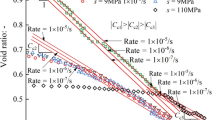Abstract
In this study, the focus is placed on addressing the challenge posed by the time-consuming nature of experimental methods employed for the determination of the hydraulic conductivity function (HCF) in unsaturated soil. Instead, preference is given to transient inflow/outflow experiments utilizing the axis translation technique. Within this framework, the flow through specimens inside a suction-controlled oedometer is modeled as a one-dimensional unsaturated seepage problem, with consideration of ceramic impedance. The impact of suction-induced volume change on unsaturated flow is incorporated into the numerical model. A novel approach for estimating internodal conductivities in numerical simulations is introduced. The transient variation of soil water mass is monitored to collect time-series water content data. This data, in conjunction with a 1-D seepage model, are used to estimate the hydraulic conductivity function. The implementation of the numerical model is straightforward, and a spreadsheet can be employed for this purpose. Importantly, the experimental setup requires no special or expensive equipment beyond what is commonly used in unsaturated soil testing. To validate the proposed numerical model, experiments were conducted on various soil types, including poorly graded sand, non-plastic silt, and highly plastic clay. The predictions are subsequently validated against data obtained from existing, sophisticated HCF determination techniques, affirming the method’s effectiveness for estimating the hydraulic conductivity function in unsaturated soils.















Similar content being viewed by others
Data Availability
All code and experimental data corresponding to methods and figure generation will be shared.
References
Ahmadi-adli M (2014) Shallow Landslides Triggered by Rainfall in Unsaturated Soils. METU, Ankara
Ahmadi-Naghadeh R (2016) Hydro-mechanical Behaviour of Unsaturated Specimens Isotropically Reconstituted from Slurry and Compacted Specimens. METU, Ankara
ASTM D5084-16a (2016), Standard Test Methods for Measurement of Hydraulic Conductivity of Saturated Porous Materials Using a Flexible Wall Permeameter, ASTM International, West Conshohocken, PA
ASTM D5856–15(2015)e1, Standard Test Method for Measurement of Hydraulic Conductivity of Porous Material Using a Rigid-Wall, Compaction-Mold Permeameter, ASTM International, West Conshohocken, PA
ASTM D6836–02(2008)e2, Standard Test Methods for Determination of the Soil Water Characteristic Curve for Desorption Using a Hanging Column, Pressure Extractor, Chilled Mirror Hygrometer, and/or Centrifuge, ASTM International, West Conshohocken, PA
ASTM D7664–10(2018)e1, Standard Test Methods for Measurement of Hydraulic Conductivity of Unsaturated Soils, ASTM International, West Conshohocken, PA
Averjanov SF (1950) About permeability of subsurface soils in case of complete saturation. Engl Collect 7:19–21
Brooks, R., Corey, A. (1964). Hydraulic properties of porous media. Hydrology Paper, 3, Colorado State University, CO
Eching SO, Hopmans JW (1993) Optimization of hydraulic functions from transient outflow and soil water pressure data. Soil Sci Soc Am J 57(5):1167–1175
Eyüpgiller, M.M., and Ülker, M.B.C. (2018). Siltlerde hidrolik iletkenlik-matrik emme ilişkisinin doygunluk derecesine bağlı belirlenmesi. 17th national congress of soil mechanics and geotechnical engineering, İstanbul
Fredlund DG (1975) A diffused air volume indicator for unsaturated soils. Can Geotech J 12(4):533–539
Klute, A., and Dirksen, C. (1986). ‘Hydraulic conductivity and diffusivity: laboratory methods: methods of soil analysis, part 1. physical and mineralogical methods. Soil science society of america, Monograph vol 9. Madison, WI, pp. 687–734.
Kool JB, Parker JC, Van Genuchten MTh (1985) Determination of soil hydraulic properties from one-step outflow experiments by parameter estimation: I theory and numerical studies. Soil Sci Soc Am J 49:1348–1354
Lu N, Likos WJ (2004) Unsaturated Soil Mechanics. John Wiley and Sons Inc., Hoboken
Mualem Y (1978) Hydraulic conductivity of unsaturated porous media: generalized macroscopic approach. Water Resour Res 14(2):325–334
Nasta P, Huynh S, Hopmans JW (2011) Simplified multistep outflow method to estimate unsaturated hydraulic function for coarse texted soils. Soil Sci Soc Am J 75:418–425
Richards LA (1931) Capillary conduction of liquids through porous medium. J Appl Phys 1:318–333
Schaap M, van Genuchten M (2006) A modified Mualem–van Genuchten formulation for improved description of the hydraulic conductivity near saturation. Vadose Zone J 5:27–34
Schelle H, Iden SC, Durner W (2011) Combined transient method for determining soil hydraulic properties in a wide pressure head range. Soil Sci Soc Am J 75:1681–1693
Van Dam JC, Stricker JNM, Droogers P (1992) Inverse method for determining soil hydraulic functions from one-step outflow experiments. Soil Sci Soc Am J 56(4):1042–1050
Van Genuchten MT (1980) A closed-form equation for predicting the hydraulic conductivity of unsaturated soils. Soil Sci Soc Am J 44:892–898
Wayllace A, Lu N (2011) A transient water release and imbibitions method for rapidly measuring wetting and drying soil water retention and hydraulic conductivity functions. Geotech Test J 35(1):1–15
Zachmann DW, DuChateau PC, Klute A (1982) Simultaneous approximation of water capacity and soil hydraulic conductivity by parameter identification. Soil Sci 134:157–163
Acknowledgements
Funding for this research was provided by the Scientific and Technological Research Council of Turkey (TUBITAK) research project No. 117M330.
Author information
Authors and Affiliations
Corresponding author
Ethics declarations
Conflict of interest
The authors declare no conflict of interest.
Additional information
Publisher's Note
Springer Nature remains neutral with regard to jurisdictional claims in published maps and institutional affiliations.
Rights and permissions
Springer Nature or its licensor (e.g. a society or other partner) holds exclusive rights to this article under a publishing agreement with the author(s) or other rightsholder(s); author self-archiving of the accepted manuscript version of this article is solely governed by the terms of such publishing agreement and applicable law.
About this article
Cite this article
Kenanoğlu, M.B., Toker, N.K. Numerical Determination of Unsaturated Hydraulic Conductivity From Time-Series Outflow Data. Indian Geotech J (2024). https://doi.org/10.1007/s40098-023-00855-9
Received:
Accepted:
Published:
DOI: https://doi.org/10.1007/s40098-023-00855-9




